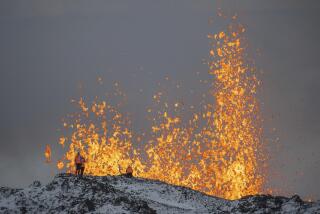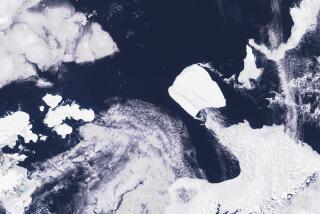Arctic’s ‘Last Ice Area’ shows earlier-than-expected melt

- Share via
Part of the Arctic is nicknamed the “Last Ice Area,” because floating sea ice there is usually so thick that it’s likely to withstand global warming for decades. So scientists were shocked last summer when there was suddenly enough open water for a ship to pass through.
The opening, documented by scientists aboard a German icebreaker, appeared in late July and August in the Wandel Sea north of Greenland.
Mostly it was due to a freak weather event, but thinning sea ice from decades of climate change was a significant factor, according to a study published Thursday in the journal Communications Earth and Environment.
While scientists have said most of the Arctic could be free of summer sea ice by midcentury, the Last Ice Area was not part of that equation. Experts figure the 380,000-square-milearea won’t be ice-free in the summer until around 2100, said study co-author Kent Moore, an atmospheric physicist at the University of Toronto.
Toward a more sustainable California
Get Boiling Point, our newsletter exploring climate change, energy and the environment, and become part of the conversation — and the solution.
You may occasionally receive promotional content from the Los Angeles Times.
“It’s called the Last Ice Area for a reason. We thought it was kind of stable,” said co-author Mike Steele, a University of Washington oceanographer. “It’s just pretty shocking. ... In 2020, this area melted out like crazy.”
Scientists believe the area — north of Greenland and Canada — could become the last refuge for animals like polar bears that depend on ice, said Kristin Laidre, a co-author and biologist at the University of Washington.
The main cause for the sudden ice loss was extraordinarily strong winds that pushed the ice out of the region and down the coast of Greenland, Moore said.
U.S. scientists report that ice in the Arctic Ocean melted to its second lowest level on record this summer.
That had happened in smaller, infrequent episodes, but this time was different, Moore said. The researchers used computer simulations and 40 years of Arctic sea data to calculate that “there was a significant climate change signal” — about 20%, they estimate — in the event, he said.
In the past, thicker Wandel Sea ice would have resisted the strong winds, but in 2020 it was thinner and “more easily broken up and pushed out,” said Walt Meier, a scientist at the National Snow and Ice Data Center in Boulder, Colo., who wasn’t part of the study.
Another part of the Last Ice Area, off Canada’s Ellesmere Island, had open waters after the July 2020 collapse of part of the Milne ice shelf, but scientists are still studying it to determine if there is a climate change connection, Moore said.









